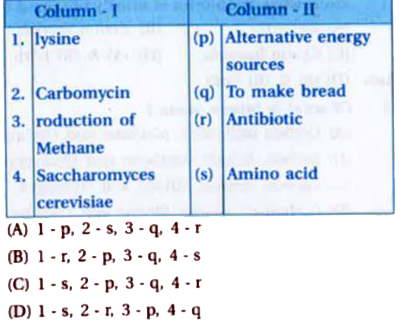Match the following columns Solution in Telugu
Solution in Telugu
The correct Answer is:A-q;B-s;C-p;D-r
A=Single step , B= Many steps
high)
Topper's Solved these Questions
- CHEMICAL KINETICSBook:AAKASH SERIESChapter:CHEMICAL KINETICSExercise:PRACTICE SHEET-1 (INTEGER ANSWER TYPE QUESTIONS)
Explore 6 Videos
- CHEMICAL KINETICSBook:AAKASH SERIESChapter:CHEMICAL KINETICSExercise:PRACTICE SHEET-2 (SINGLE OR MORE THAN ONE OPTION QUESTIONS)
Explore 16 Videos
- CHEMICAL KINETICSBook:AAKASH SERIESChapter:CHEMICAL KINETICSExercise:PRACTICE SHEET-1 (LINKED COMPREHENSION TYPE QUESTIONS)
Explore 6 Videos
- CHEMICAL KINETCSBook:AAKASH SERIESChapter:CHEMICAL KINETCSExercise:EXERCISE - 3.2
Explore 45 Videos
- CHEMICAL THERMODYNAMICSBook:AAKASH SERIESChapter:CHEMICAL THERMODYNAMICSExercise:Additional Practice Exercise
Explore 54 Videos
Similar Questions
In a gaseous phase reaction A2(g)→B(t)+1(1/2)C(g), the increase in pressure from 100 mm to 120 mm is noticed in 5 minute.The rate of disappearance of A2 in mm min−1 is
View SolutionThe rate constant (K) for the reactio. 2A+B→ Products was found to be
2.5×10−5litremol−1sec−1 after 15 sec, 2.60×10−5 litre mol−1sec−1 after 30 sec and 2.55×10−5 litre "mol"^(-1)"sec"^(-1) after 50 sec. The order of reaction is
View SolutionThe instantaneous rate of an elementary chamical reactkon aA+bB⇔cC+dD can be given by rate =Kf[A]a[B]b−Kb[C]c[D]d where Kf and Kb are rate constants for forward and backward reactions respectively for the reversible reaction. If the reaction is an irreversible one, the rate is expressed as, rate =K[A]a[B]b where K is rate contant for the given irreversible rate of disappearance of A is a/b times the rate of disappearance of B. The variation of rate constant K with temperature is expressed in terms of Arrhenius equation: K=Ae−Ea/RT whereas the ratio KfKb is expressed in terms of van't Hoff isochore: KfKb=Ae−ΔH/RT, where Ea and ΔH are energy of activation and heat of reaction respectively.
The variation of rate constant K and KfKb with temperature shows the following effects:
For endothrmic reaction when T increases then K increases and KfKb also increases.
(ii) For endothemic reaction when T decreases then K decreases and KfKb also decreases.
(iii) For exothermic when T increases then K and KfKb both increases.
(iv) For exothermic reaction when T decreases then K increases and KfKb decrease.
(v) For exothermic reaction when T increases thenK and KfKb both decrease.
View SolutionDiscuss on the kinetic spontaneity of a chemical reaction. Is a slow reaction spontaneous? Why?
View SolutionWhich among the following is not an exact differential?
View SolutionMatch the following column with column

View SolutionMatch the following columns Column

View Solutionनिम्न कॉलमों का मिलान कीजिए। कॉलम ।

View Solutionनिम्न कॉलमों का मिलान कीजिए। कॉलम ।

View Solutionनिम्न कॉलमों का मिलान कीजिए। कॉलम ।

View Solutionनिम्न कॉलमों का मिलान कीजिए। कॉलम ।

View Solutionनिम्न कॉलमों का मिलान कीजिए। कॉलम ।

View Solutionनिम्न कॉलमों का मिलान कीजिए। कॉलम ।

View Solutionनिम्न कॉलमों का मिलान कीजिए। कॉलम ।

View Solutionनिम्न कॉलमों का मिलान कीजिए। कॉलम ।

View Solutionनिम्न कॉलमों का मिलान कीजिए। कॉलम ।

View Solution

